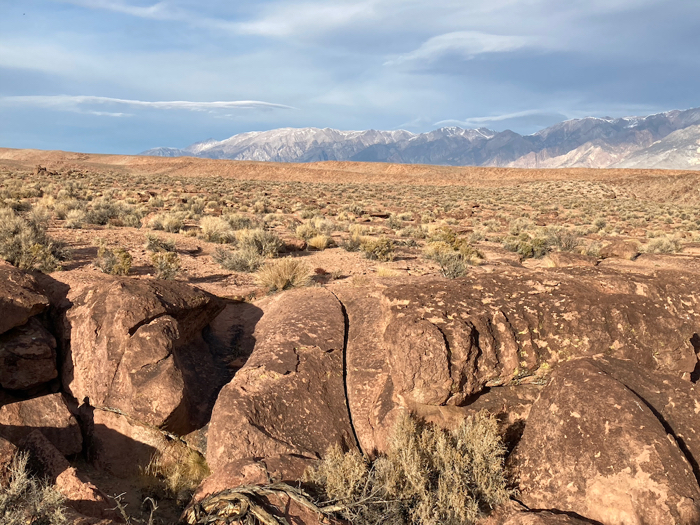Homage to Payahuunadü
December 15, 2022
Artist Statement for solo exhibition at C5 Studios Community Art Center, Bishop CA
When I moved to the Owens Valley a few years ago I felt a deep affinity for this landscape, nurtured over repeated visits spanning decades, but I had only cursory knowledge of its history and ongoing struggle for ecological and cultural integrity. In the time that I have lived here, I have tried to learn more about the region, in particular through the voices of its first inhabitants. Through reading, watching documentaries, taking in lectures and attending local events, I have begun to fill in the gaps and to see and appreciate what Payahuunadü (the Paiute name for the Owens Valley) was and is.
I was Always struck by the overwhelming presence of this land – two massive 14,000 foot mountain ranges flanking the deepest valley in the US, the vast sky that is a stage for a never ending drama of clouds and shifting light, and the inhospitable barriers of heat and rough terrain that render much of the landscape impenetrable in summer. This is what I came for, year after year. The impression of overpowering nature still remains, but my appreciation of this place has become deeper and richer the more I have studied it.
What I have learned, most of all, is that this land has been home – a lifegiving, enduring home – for people for thousands of years, and that those first people are here still, caring for the land and keeping alive the memory of what it once was. That the valley floor, which appears now to be mostly parched sagebrush, once brimmed with water and sustained cultivated fields of food crops. Before the arrival of European settlers, Bishop Creek watered 3,500 acres of cultivated land; Horton Creek over 9,000. The fields consisted of large terraces holding fine, rich soil, several feet deep. The canals and ditches that fed the terraces were carefully calibrated so that the sediment they carried settled in the beds and were not swept away. These extensive water systems were in continuous use for at least 400 years beginning in the 14th and 15th centuries. They sustained the Nüümü, as the Paiute called themselves, the people that wove the exquisite baskets that can be found at the Paiute Shoshone Cultural Center in Bishop and the Museum of Eastern California in Independence, works of stunning beauty and design. They who are today at the forefront of fights to protect the land from the predatory extraction of water and other resources.
As an artist I have drawn inspiration and nurture from this land for decades, so it is with deep respect and thanks that I dedicate this exhibition to the vision of Payahuunadü as it was and is still in the memories and hopes of its Indigenous people, and to their current struggles to protect the land. As a more recent transplant, I acknowledge that I own and inhabit land that was taken from the Paiute people. How to hold this difficult truth and begin to address it in a meaningful way is a journey that I and many others across the country are embarking upon.
Wherever it takes us, I think we can all agree that we are in a critical moment in our human history on this planet. We who live in Payahuunadü are blessed in that this particular place presents an opportunity to restore a deep and potent vision of humans living in reciprocal relationship with the land. The irony of the water theft by the city of Los Angeles is that the valley itself remains remarkably free of development. It is suffering, the vegetation dying as the water table drops from excessive pumping. But it is open, it’s surfaces not yet paved over. Restoration is imaginable.
Keep the water and heal the land.
Tablelands Ramblings
March 31, 2021
The Tablelands are a unique geologic formation that lies to the north of Bishop, formed by a massive pyroclastic flow from the Long Valley caldera eruption approximately 700,000 years ago. It is the place we go to wander in the winter when the Sierra are covered in snow. Riddled with hidden canyons that harbor ancient petroglyphs, the remnants of wick-i-ups, and nesting colonies of owls among other things, it is a world unto itself, enigmatic and mysterious.


